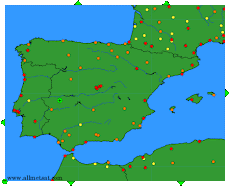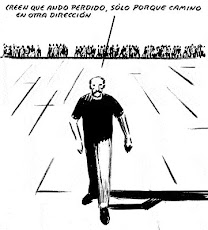miércoles, 9 de mayo de 2012
TORMENTA EN EL AEROPUERTO DE MADRID-BARAJAS
Viernes 4 de mayo de 2012, entre las 19 y 21 horas una tromba de agua descargó sobre el Aeropuerto de Madrid-Barajas, unas horas antes se había registrado la racha máxima de viento, que alcanzó los 59 km/h. Los datos de lluvia que ofrece la AEMET, recogidos en la estación meteorológica del mismo aeródromo, no son excepcionales; no obstante, dada la distribución irregular de las precipitaciones durante ese día, es posible que en lugares cercanos fueran más intensas.
Una lectora de Las mentiras de Barajas nos ha enviado unas fotos de los aviones que en ese momento aterrizaban por la pista 18R. Aquí mostramos algunas y le agradecemos públicamente la deferencia que ha tenido hacia nuestros lectores.
Recordamos que uno de los riesgos del Aeropuerto de Madrid-Barajas (catalogado como Riesgo 6) es la posible colisión, en caso de aterrizaje largo, de los aviones que toman pista por la 18R y 18L, en configuración Sur, contra las aeronaves estacionadas que aguardan haciendo cola para el despegue por las pistas 15R y 15L. Este mismo riesgo existe en configuración norte, entre los aviones que aterrizan por las pistas 33R y 33L y los que aguardan haciendo cola para el despegue por las pistas 36R y 36L.
Cuando la pista de aterrizaje está llena de agua por la lluvia intensa las ruedas pierden adherencia. En el caso extremo, cuando el contacto entre la superficie de la pista y la superficie de la rueda se pierde, entonces tiene lugar el fenómeno del aquaplanning, cuando se pierde el control de la dirección y la frenada pierde eficacia, lo que puede provocar una salida lateral de la pista o un aterrizaje más largo. Además, en este aeródromo, las consecuencias del aquaplanning pueden agravarse dado que en la mayoría de los casos se obliga a los aviones a operar con el viento de cola.
Adjuntamos el artículo técnico disponible en SKYbrary sobre Aquaplanning.
Aquaplanning
Source: www.skybrary.aero
Categories: Theory of Flight | Enhancing Safety | Overrun on Landing | Directional Control | Runway Excursion
Description
Aquaplaning, also known as hydroplaning, is a condition in which standing water causes the moving wheel of an aircraft to lose contact with the surface on which it is load bearing with the result that braking action on the wheel is not effective in reducing the ground speed of the aircraft.
The continued incidence of aquaplaning reduces the braking co-efficient to that of an icy or "slippery" runway - less than 20% of that on a equivalent dry runway.
Causal Factors
A layer of water builds up beneath the tyre in increasing resistance to displacement by the pressure of the wheel. Eventually, this results in the formation of a wedge between the runway and the tyre. This resistance to water displacement has a vertical component which progressively lifts the tyre and reduces the area in contact with the runway until the aircraft is completely water-borne. In this condition, the tyre is no longer capable of providing directional control or effective braking because the drag forces are so low. If such a runway surface state prevails, then flight crew are required to make their aircraft runway performance calculations using "slippery runway" data; this specifically allows for poor deceleration. They must also take account of crosswind component limits in the AFM which make allowance for less assured directional control.
Aquaplaning can occur when a wheel is running in the presence of water; it may also occur in certain circumstances when running in a combination of water and wet snow. Aquaplaning on runway surfaces with normal friction characteristics is unlikely to begin in water depths of 3mm or less. For this reason, a depth of 3mm has been adopted in Europe as the means to determine whether a runway surface is contaminated with water to the extent that aircraft performance assumptions are liable to be significantly affected. Once aquaplaning has commenced, it can be sustained over surfaces and in water depths which would not have led to its initiation.
In the case of the most common type of aquaplaning, called dynamic aquaplaning (see below), a simple formula exists which can calculate the minimum groundspeed for initiation of this type of aquaplaning on a sufficiently wet runway based upon tyre pressure:
for groundspeed in knots = V and tyre inflation pressure in psi = P
V = 8.6 x √P
This formula is based upon the validation of hydrodynamic lift theory by experimental evidence. The effect of the relationship demonstrated is that most jet aircraft, even relatively small ones, have a significant ‘window’ for the initiation of dynamic aquaplaning during a landing near to the maximum approved weight and an even larger one in the case of a high speed rejected take off. It assumes that tyre pressure and tread depth are both within allowable AMM limitations.
Types of Aquaplaning
• Dynamic aquaplaning is that which does not begin unless the tyre-pressure moderated ground speed as determined above is exceeded. It leaves no physical evidence on tyre or runway surface.
• Viscous aquaplaning arises in the same way as dynamic aquaplaning, but only on abnormally smooth surfaces such as touchdown zones contaminated with excessive rubber deposits, where it may begin and continue at any ground speed. Typically, a small amount of water may mix with a surface contaminant. It too leaves no physical evidence on tyre or runway surface.
• Reverted rubber aquaplaning occurs when the heat of friction from a locked wheel in contact with the surface causes the reversion of the rubber to its un-cured state and 'boils' the surface moisture into steam. The pressure of the steam raises the centre of the tyre off the surface whilst the edges remain in contact, forming a seal which temporarily traps the steam. The tyre will show clear evidence of rubber reversion and the runway surface will be clearly marked with the path of the wheels as a result of ‘steam pressure cleaning’ beneath the tyre. This is the only type of aquaplaning which leaves physical evidence on the runway surface. It was much more common before anti-skid units became widespread and usually only occurs to aircraft so fitted if an emergency brake, which is applied directly rather than through the anti-skid units, is used.
Dry Runway Friction
The friction status of a dry runway surface must be assessed periodically under the terms of ICAO TPN 13. It should also be re-assessed after any maintenance which might have affected the surface smoothness. Dry runway friction is directly related to the lesser friction when a runway is wet and this affects the braking coefficient. The ICAO guidelines are not prescriptive in detail and so a range of interpretations is possible. In particular, averaging of measured friction along a whole runway or even significant lengths of it can conceal considerable variation since averaging is not always associated with extremes or with general statistical measures of variation about such an average.
Flight crew are aware that the touchdown zone (TDZ) on many runways can be affected to some degree by rubber deposits from landing aircraft. These deposits should be regularly removed to achieve a stated minimum dry friction level, but sometimes this may not happen and the actual surface friction in the TDZ can then be noticeably worse than along the rest of the runway. If a finding of low friction is made for the TDZ or any other part of a runway during regular inspections or a planned maintenance work then, unless rectification can be immediately achieved, NOTAM action to the effect that the runway is liable to be slippery when wet should be taken. Any such low friction condition is conducive to viscous aquaplaning beginning below the ‘aquaplaning speed’ and therefore ‘slippery runway’ landing performance data should be used.
Runway Surface State
The surface state of a wet runway can be assessed by either:
• the depth of water in the touchdown zone, or
• the measured or observed braking action.
In some parts of the world, a standard terminology which describes a runway as dry, damp, wet, wet with water patches or flooded is in use; this is often found in association with the use of 3mm water depth over a significant part of the runway as the division between a normal runway and a contaminated one for aircraft performance purposes. It is the responsibility of the Airport Operator to communicate this information, or a local equivalent, to pilts; ATC are merely the means of communication. If ATC suspect that it is inaccurate or no longer valid, they may choose to give their own assessment made from the visual control room (VCR), but this should be prefaced by the qualification 'unofficial'
It is unlikely that the actual depth of water on a runway will be passed to an aircraft by ATC; at present, equipment which takes tactical friction measurement on wet runways (as opposed to surfaces with frozen deposits) is rarely authorised for use, so the best information a pilot is likely to get prior to landing is an informal braking action comment made to ATC by a previously landed aircraft. This should be passed by ATC with the time of the report, the aircraft type which made it and any significant change in precipitation since it was received. Prior to takeoff, direct observation should enabled the pilot to form a first hand impression of the surface state and the extent to which water is present on it. This will be particularly important in the event of a rejected take off.
The speed with which water drains from a runway surface is affected by the geometry of the surface and by whether or not it is grooved, or has a porous surface layer. Airport and runway licensing requirements limit the extremes of surface geometry, and exceptions allowed by an NAA should be published in the State AIP from where they should be replicated as Notes in the commercially published Flight Guides used by most pilots on the flight deck. Even normal surface geometry may lead to unusual water depth variation if a significant crosswind component exists; the effect of this could be periods of asymmetric braking if one main gear assembly (likely to be the downwind one) is braking normally whilst the other is aquaplaning. Where an abnormal pavement geometry is promulgated, the potential effect of the exceptions on any intended landing or take off should be assessed at the time.
It is widely recognised that the present arrangements for communicating likely runway braking action or actual surface friction measurements on wet runways are unsatisfactory and much attention continues to be given to developing an improved system.
Defences
Avoiding Aquaplaning
• If there is any doubt as to the probable extent of water of depth greater than 3mm on the landing runway, then an alternative runway should be chosen.
• If the flight crew become aware, just before landing, that the depth of water on the runway, especially in the touchdown zone, has increased to an extent that aquaplaning is likely, then a go-around should be flown. If this circumstance is not apparent until touchdown, then, provided it is permitted by the AFM, the landing should be promptly rejected from the runway.
• If it is decided that to continue an approach to a landing, a stabilised approach is required which results in the aircraft crossing the runway threshold at the correct airspeed and height so as to achieve a touchdown within the TDZ. This is especially important when the landing distance required is close to the landing distance available.
General Airmanship Considerations
• The pilot should be aware of the aquaplaning speed derived from the fully-inflated tyre pressure for both the maximum takeoff mass and maximum landing weight.
• Careful attention should be paid to the appearance of the tyres during the pre-flight external check, as far as this is possible, especially the depth of tread. Even though having the tyre pressure within allowable limits is important, it can be extremely difficult to assess this visually on multi-wheel landing gear.
• The main gear touchdown on a wet runway should always be firm and made without any bounce in order to break through the surface water film and make effective contact with the runway surface.
Braking, Spoiler Deployment, Thrust Reversers and Control Column Handling
• Once touchdown on all of the landing gear has been achieved and sustained, SOPs usually recommend application of positive forward control column pressure in order to reduce the wing incidence, and therefore the lift, and thereby to assist in imposing the full aircraft weight onto the landing gear.
• A significant crosswind component may result in a difference between the amount of weight transferred onto each main gear assembly. This is because, even with the wings being held level by into-wind aileron, fuselage shielding partly blanks the downwind wing. This increases the likelihood of difficulties with directional control in a situation where the possibility of transient differential aquaplaning may also exist.
• Where available, full reverse thrust or reverse pitch should be selected whilst the ground speed is still high in order to gain maximum effect. Full ground spoiler deployment should also be made as soon as all wheels are on the ground if manual selection is necessary. Auto deployment of ground spoilers may be delayed until a specific wheel rotational speed, perhaps 25 kts (46.3 km/h, 12.85 m/s), is sensed. Brake Units are likely to have anti-skid systems fitted so that any applied brake pressure by-passes the units until a specified wheel rotational speed is reached after touchdown. Typically, this could be 50 kts (92.6 km/h, 25.7 m/s). Auto-braking selection should follow AFM requirements and Operator SOPs; manual braking may be inhibited until a specific time after the final touchdown is sensed. It is important to understand how each of these contributions to deceleration work so that if aquaplaning should occur, it is recognised as such rather than mistaken for a system malfunction.
Recovery from Aquaplaning
• Aquaplaning should be avoided if at all possible because, once it has begun, there is no certain way of regaining control and establishing useful deceleration.
• In the case of continued aquaplaning, deceleration can be expected to correspond to that for a slippery runway with braking coefficient of around 0.05. Around 50% more stopping distance will be needed if thrust reversers are not available and around 25% if they are (since account is not taken of their effect for normal landing performance calculations).
• Prior to attempting a landing on a runway where aquaplaning is likely, check that sufficient 'slippery runway' landing distance exists so that a runway excursion will not follow if aquaplaning commences.
• If there is a significant crosswind component, a landing on a potentially slippery runway should not be attempted. AFM limitations usually impose specific restrictions on allowable crosswind component for this case.
• Apart from an immediate [Rejected Landing|rejected landing]] where AFM limitations and Operator SOPs allow it, there is little that can be done if aquaplaning begins and continues. If manual braking is being used, then briefly releasing and then reapplying pressure may succeed in increasing braking effectiveness. However, under no circumstances (except gross malfunction) should anti-skid be disabled since hard braking on a wet runway without this protection is certain to lead to reverted rubber aquaplaning and a decrease in deceleration due to locked wheels.
Example Accidents and Incidents
• B744, Bangkok Thailand, 1999 (RE HF WX) - On 23 September 1999, a Boeing 747-400 being operated by Qantas on a scheduled passenger service from Sydney Australia to Bangkok overran Runway 21L during an attempted night landing in normal visibility and came to a halt substantially intact 320 metres beyond the runway end.
• E135, George South Africa, 2009 (RE GND) - On 7 December 2009, after a relatively normal touchdown at destination in unexceptional daylight conditions, an EMB 135 being operated by South African Airlink on a scheduled passenger flight from Cape Town to George failed to decelerate normally and overran the end of the runway resulting in major damage to the aircraft and injuries to 7 of the 30 passengers on board and to all three aircrew.
• E145, Hanover Germany, 2005 (RE HF WX) - On 14 August 2005, an Embraer 145 being operated by British Airways Regional on a scheduled passenger flight from Birmingham to Hanover overran the wet landing runway by 160 metres in normal visibility after flying a daylight ILS approach with the approach lights visible from about 4 nm.
Related articles and further readings were not included but are available in the skybrary article.
Recordamos también el accidente que tuvo lugar en el Aeropuerto de Sao Paulo (Brasil) el 17 de julio de 2007, el más grave de la historia de Brasil, en el que murieron 199 personas, entre tripulación (6), pasajeros (181) y viandantes (12). En el momento del accidente una intensa lluvia descargaba sobre la zona. El avión, de la compañía brasileña TAM, se salió de la pista de aterrizaje, cruzó la avenida Washington Luis y, girando levemente, se estrelló contra un edificio de la propia TAM Express que incluía una estación de combustible.
Pulsar aquí para consultar los datos técnicos de la Aviation Safety Network.
Casualmente el día anterior tuvo lugar otro accidente en el mismo aeropuerto, aunque afortunadamente sin víctimas, y por la misma causa. Pulsar aquí para consultar los datos técnicos de la Aviation Safety Network.
Está visto que de la experiencia propia no todas las veces se aprende, y de la ajena nunca.
Suscribirse a:
Comentarios (Atom)




















